Musings on my mid-1790's Gown
(1797)
I've talked much about wanting to make the quintessential white Regency gown for this year's Jane-Austen-Festival, and now that my stays are done, I've finally been able to start the process of turning that want into a reality. Last Autumn, I purchased some white voile from Dharma Trading Company (I think that's where I purchased it...I've slept since then). I'm using this for my gown, but before I cut into this heavenly-oh-so-soft-and-scrumptious fabric, I'm carefully planning everything out and testing out my plans using a cheap old white sheet, and draping my ideas over my dress form.
(1799 - love the scarf...the veil...not so much)
But let me take a step back...
...all perfect gowns start with a solid foundation.
My Stays are done...check (except for the scrunching problem in the back, which I am currently working on.)
I've re-done my old petticoat...check. It now fits better, and looks better. The only thing I have to worry about is getting it to stay up at such a high waistline. I'm thinking of buttoning it to my stays (which is a period correct way of doing it)...or I might use straps (also period correct)...or I could just pin it to my stays (a third period correct method.) Any one of these ways should work.
Another foundational object that I am told is necessary is something called a "bum roll"....umm...yes, I know it's a funny word...I laugh when I say it too. Why anyone would WANT to make their bum bigger, I don't know, but such was the fashion at the time...and...well...when in Rome... Originally, I made one that looked like the above picture... a sort of rectangle-ish one (I've seen others like it).
But then my dear, wise and clever friend, Natalie, over at A-Frolic-Through-Time pointed out that something this big might show through the semi-sheer voile. Good point, Natalie. So, I made one smaller. It's much nicer, don't you think. The fabric at the back of the skirt should drape well over this one.
The only thing lacking in the undergarments department is a pair of clocked stockings, like the ones at Burnley&Trowbridge....but I'm trying not to spend any money on myself this year (why is this so stinkin' hard!), so they might have to wait.
(1793)
Ok, so, foundational stuff out of the way now...back to the gown. The first thing I did, was to grub up some inspiration. I needed a Muse...or two...or three... Fashion plates, paintings and extant garments are the way to go. I was fortunate enough to find all three.
(Tiden's Toj gown)
Let's talk extant garment. THE ultimate white gown, that everyone interested in the Regency period seems to covet and wish to reproduce is the 1797, Dutch, Tiden's Toj, white wedding GOWN. I know that Natalie is using this as inspiration for her gown, and Lauren at American-Duchess is making a gorgeous version of the dress. It even comes with it's own PDF graphed pattern (which I can't read because it's in Dutch.)
I love the beautiful folds, gathers and pleats, and I'm confident that my voile will take this shape nicely. I'm also in love with the v-neck (or slightly crossover) style, which suits my figure, and the high neckline is gorgeous. Just take a look at the detailed pleating on the back bodice. It's positively sculptural.
(Mrs. Unknown)
The paintings that caught my eye were two miniatures from the V&A. First, was this one of an unknown lady from 1795. I like her turban as well.
(Mrs. Skottowe)
The second was of Mrs. Skottowe from 1800. Both of these ladies are wearing a v-neck, gathered white gowns with fairly high back necklines.
(1796)
The final inspiration comes from fashion plates. I found two sites that make me giddy. The first is the Bibliotheque-des-arts-decoratifs which, obviously is in French (which I don't speak, and If I were stranded in a French speaking country, could maybe be able to read enough to get me to a bathroom, or let someone know I am thirsty or hungry.) Anyhow, it's a tricky site to navigate, but has some amazing fashion plates within it.
(1794)
The second site, is much easier to use, but it doesn't have quite as many fashion plates. That being said, the ones it does have are outstanding. It's called Dames-a-la-mode, it's written in English, and this is where most of the fashion plates you are seeing now come from.
(My scribblings...I apologize for the dark blurriness of the image...bad lighting, and I'm a bit too lazy to retake the picture...sorry.)
I also found a bit of inspiration in the book, "Costume in Detail" by Nancy Bradfield. On page 81 of this book is a beautiful illustration of a gown from the Snowshill Collection. I love the layout of this book, with all of it's sketches and scribbled thoughts. This is exactly how I lay out my ideas.
Once my Muse was captured, I set about creating my pattern, and draping. Most of what I've been playing with was drafted, with some of it adapted from old Sense and Sensibility patterns and muslins of other gowns I've made. Once you've made a certain style of clothing, there are an infinite number of ways to manipulate that basic design. It isn't any different with historical costuming.
I used the back bodice design...
...and the front flaps idea, of the Snowshill gown as my lining. I need to take off a couple of inches from the bottom of the front bodice lining, and raise the top edge a couple of inches as well.
Like I said before, I am using an old sheet for my muslin. It is quite a bit heavier than the voile, so the tucks and pleats will probably have to be done a little finer. I will also be tacking down the outer bodice to the lining in many places. Here's what I have so far for the front...
...and this is what's done on the back. It looks a little Frankenstein-ish at this point, and obviously, I have some tweaking to do still. You might even be able to see my handwriting on the fabric. This was my second muslin, and there might be a third. I haven't even started on the skirt part of the gown yet. I'm leaning toward a drop front skirt, that ties at the side seams.
Actually, I played around with the voile too (without cutting), and I'm thrilled with the look! I'm giddy, really! You can see the comparison above. The sheet is on the left, and the voile is on the right.
I can't wait to finalize the muslin, and fit it to myself so that I can start working with the voile. But first, I have to work out all of the construction issues...I'm planning on sewing the gown by hand!



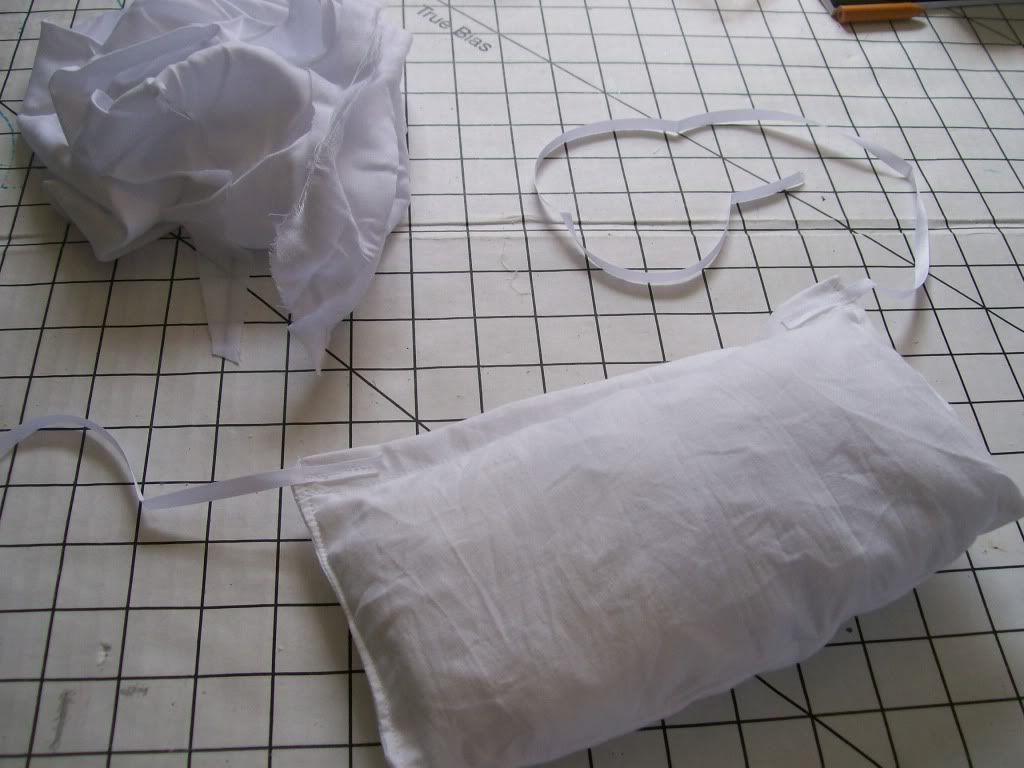








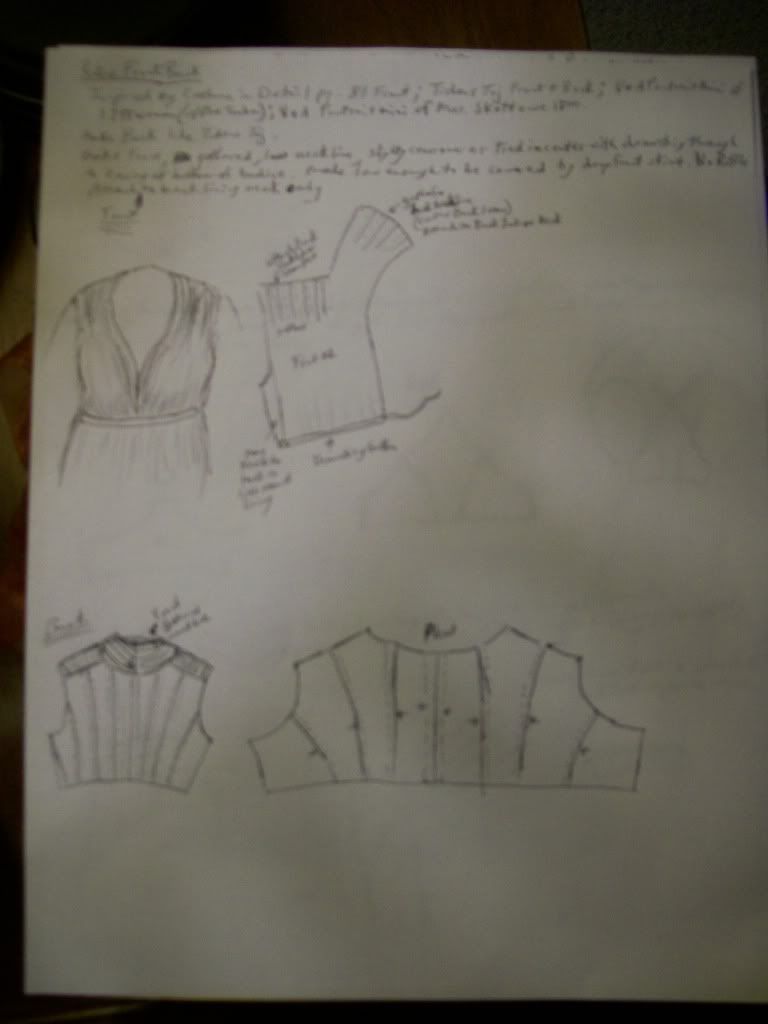



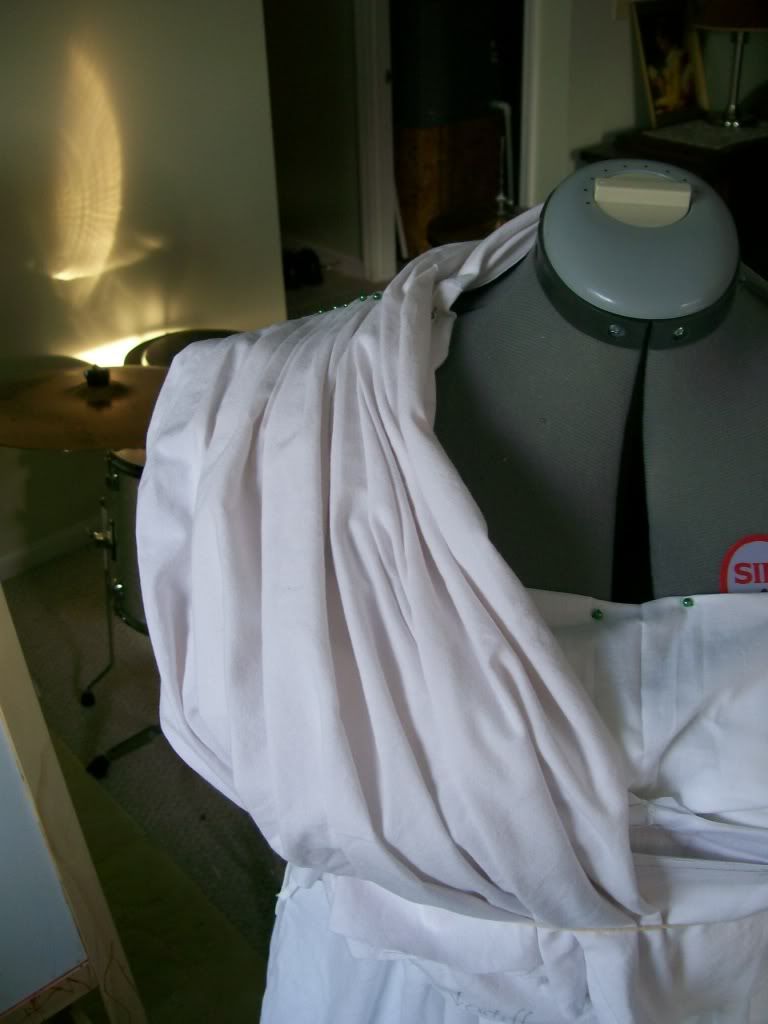
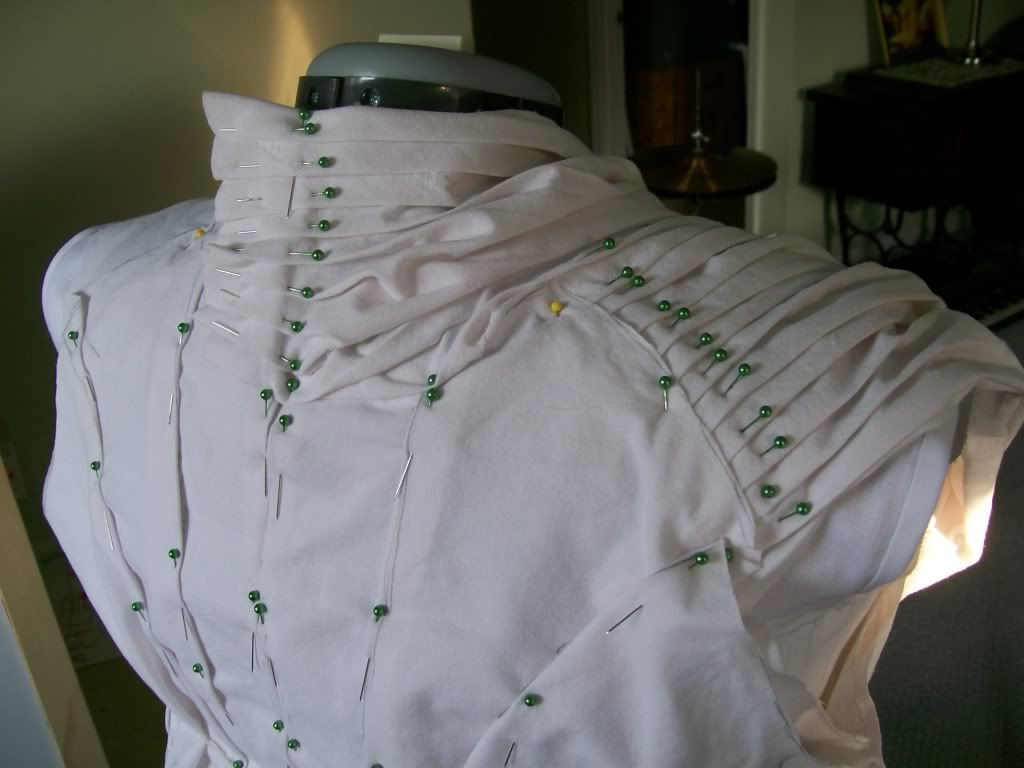
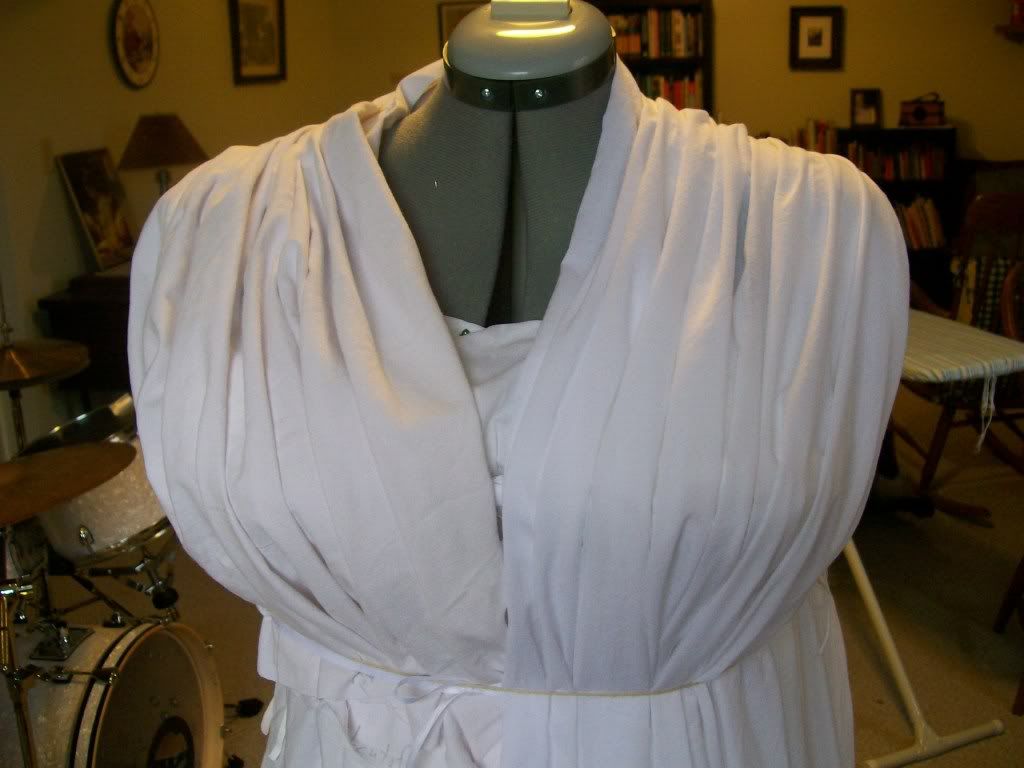
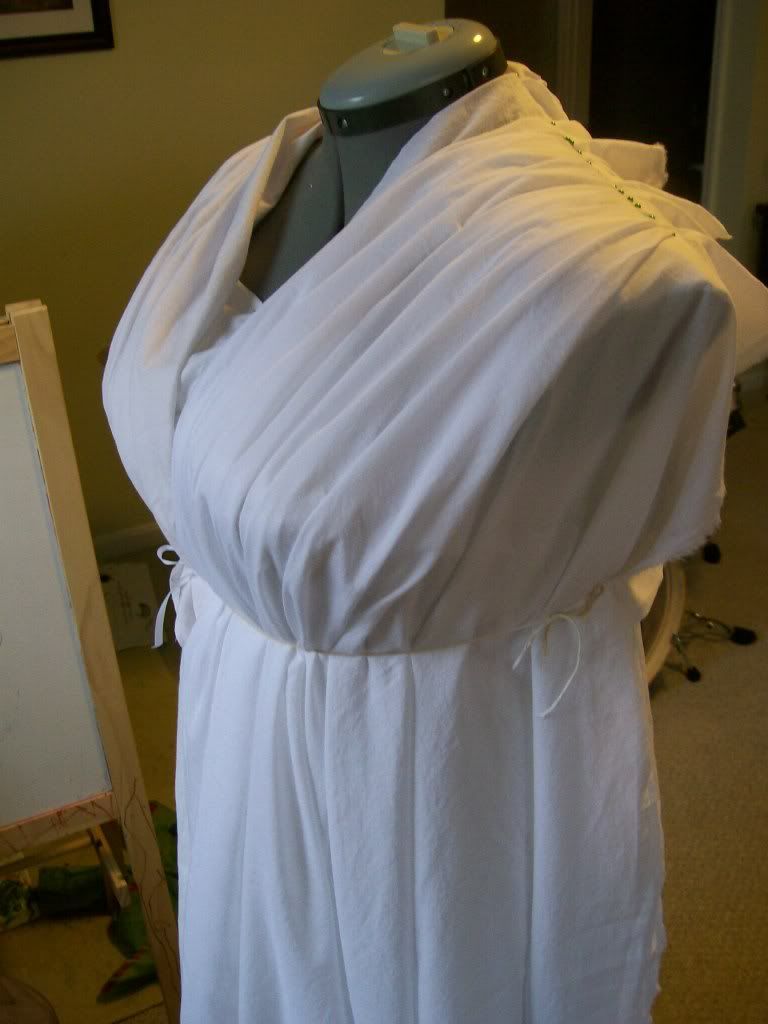

Comments
It's looking *really* good, and that neckline is really going to make the dress, giving the front presence.
Had you thought of using a wee fewer gathers towards the shoulder edge, as in Mrs. Skottowe's portrait? It's a small change, but allows the neck edge gathering to stand out more like a frame, while the armscye gets less attention, and thus looks thinner. They liked that slope-shouldered look :}
Very best,
natalie
Nabila - Thank you very much!
Sarah - The pleats are so much fun and elegant looking. I can't wait to see what you come up with.
Natalie - I definately need to work on the pleats in the outer shoulder area. Other than needing to tone it down a bit, I am not quite sure yet, how to deal with the side seam/armsythe. Still playing with it...
I happened to see that the pattern you linked to isn't in dutch, but it norweigean, which I as a swede can read quite easily. Mail me if you want me to translate! :)
//Alva (maria @ anubis.nu
The 6th image down is quite close to what my dress looks like.
Have you worn this dress with a bum roll yet? I wondered I should make one.